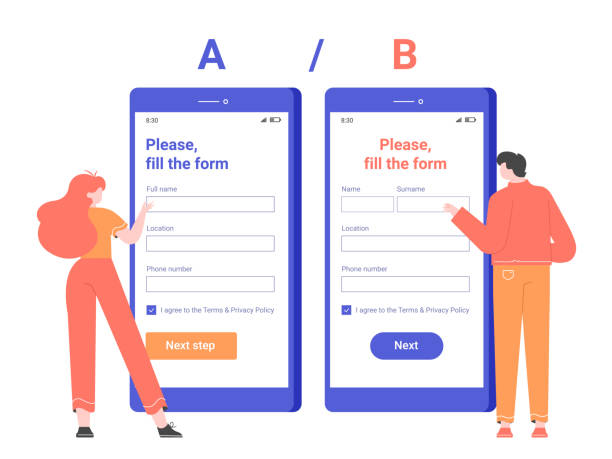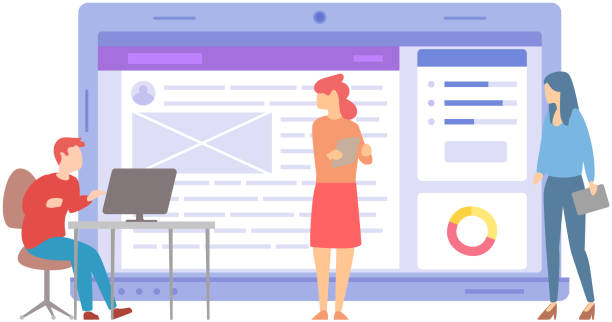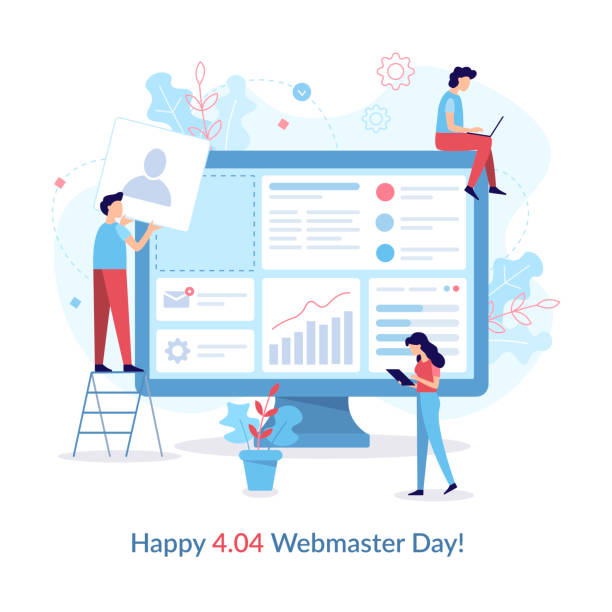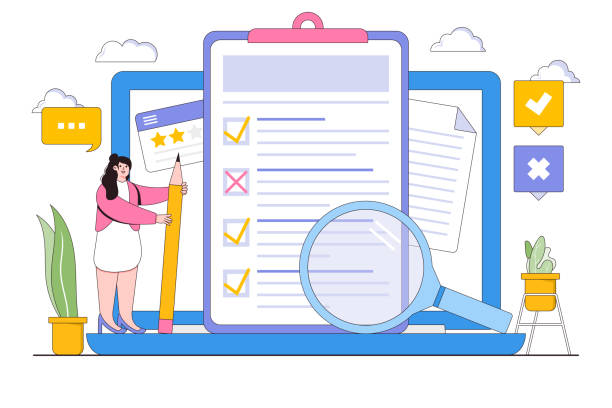Introduction to the Importance of Secure Website Design

In the current digital age, where most of our daily activities have shifted to the online space, the topics of #Web_Security and #Secure_Website_Design have become more important than ever.
Every website, from a simple personal blog to large e-commerce platforms and online banks, is exposed to numerous security threats.
A small flaw in the security system can lead to the loss of sensitive data, violation of user privacy, damage to business reputation, and even significant financial losses.
Therefore, special attention to security principles throughout all stages of the website development lifecycle, from initial design to deployment and maintenance, is a vital necessity. The goal of this explanatory article is to provide a comprehensive guide for web professionals and developers to create websites with the highest level of security.
Recent news of widespread cyberattacks on prominent global websites clearly demonstrates the need to enhance knowledge and implement stringent security standards.
Designing and implementing infrastructure resistant to cyberattacks not only protects sensitive information but also gains user trust and ensures the stability of online activities.
This introductory news piece emphasizes the importance of an explanatory and comprehensive approach to enhancing website security, so that we can have robust and reliable systems against growing threats.
Does your current website convert visitors into customers, or does it drive them away? Solve this problem forever with professional corporate website design by Rasawp!
✅ Build strong credibility and branding
✅ Attract target customers and increase sales
⚡ Get a free consultation now!
Common Threats and Web Vulnerabilities

To achieve secure website design, we must first become familiar with common threats and vulnerabilities in the web space.
Cyberattacks on websites are carried out through various methods, each relying on a specific type of vulnerability.
One of the most well-known attacks is SQL Injection, or SQL Injection, which allows an attacker to take control of the database by injecting malicious code into input fields.
XSS attacks (Cross-Site Scripting) also steal user information or execute unwanted behaviors by injecting malicious scripts into web pages.
CSRF attacks (Cross-Site Request Forgery), phishing, DDoS attacks, and Brute Force attacks for guessing passwords are other serious threats.
Specialized knowledge about these vulnerabilities and methods to counter them is the foundation of any effort to enhance web security. A detailed analysis of potential risks helps developers prevent these attacks by adopting preventive measures.
The analytical content of this section is designed to understand the depth of challenges in the field of web security.
Principles of Secure Coding and Attack Prevention

A major part of secure website design revolves around adhering to secure coding principles at the core of application development.
Secure coding means writing code that is resistant to common attacks and minimizes potential weaknesses. This instructional guidance includes thorough validation of user inputs; any data entered by the user must be carefully checked and sanitized to prevent the injection of malicious code.
Using Prepared Statements in the database to prevent SQL Injection, as well as using appropriate output encoding functions to prevent XSS, are among the essential measures.
Furthermore, strong encryption should be used for storing passwords (such as using hashing functions with Salt) and other sensitive information.
Proper session management and the use of CSRF tokens to protect against cross-site request forgery attacks are also of high importance.
Regularly updating used libraries and frameworks and avoiding the disclosure of sensitive information in error messages are other crucial recommendations for enhancing code security.
The table below shows some common mistakes and secure coding solutions:
| Common Mistake | Vulnerability | Security Solution (Explanatory) |
|---|---|---|
| Lack of input validation | SQL Injection, XSS | Use input filtering and sanitization, Prepared Statements |
| Storing passwords in plain text | Disclosure of user information | Use hashing with Salt and strong algorithms (e.g., bcrypt) |
| Improper session management | Session Hijacking | Use HttpOnly and Secure cookies, regular session expiry |
| Disclosure of error information | System information disclosure | Display generic error messages to the user, log detailed errors |
Database Security

The database is the heart of every website and the primary repository for sensitive data; therefore, its security plays a vital role in secure website design. Database protection goes beyond mere input validation in code and requires specialized, multi-layered approaches.
The first step is to use the Principle of Least Privilege for database users.
Every user or application should only have access to the minimum data and operations required.
For example, a web application that only needs to read information should not have write or delete access.
Furthermore, encryption should be used for sensitive data at rest in the database and in transit between the application and the database. This specialized guidance emphasizes that regular and encrypted backups of the database, stored in a secure location, are essential for recovery in case of an attack or disaster.
Database ports should only be accessible from within the internal network, and their exposure to the public internet should be avoided.
Powerful firewalls and Intrusion Detection Systems (IDS) can also help monitor and block suspicious traffic.
Regularly updating the Database Management System (DBMS) to fix known vulnerabilities is another critical measure.
These measures form the cornerstone of protecting data against unauthorized access and malicious attacks.
Does your current corporate website present a worthy image of your brand and attract new customers?
If not, turn this challenge into an opportunity with Rasawp’s professional corporate website design services.
✅ Significantly improves your brand’s credibility and image.
✅ Paves the way for attracting new leads and customers for you.
⚡ For a free and specialized consultation, contact Rasawp now!
Authentication and Authorization Mechanisms

Authentication and Authorization are two main pillars in secure website design that manage user access to the system and determine their access levels. Authentication is the process of verifying a user’s identity, while authorization specifies what resources the verified user can access.
For secure authentication, using strong and complex passwords that include a combination of uppercase and lowercase letters, numbers, and symbols is essential.
Additionally, implementing Two-Factor Authentication (2FA), which requires verification via a code sent to mobile or email in addition to the password, significantly enhances security.
This instructional approach is important for both the user and the developer.
In the authorization section, Role-Based Access Control (RBAC) models should be used, meaning each user, based on their role (e.g., administrator, editor, regular user), gains specific access levels.
This explanatory and systematic approach prevents unauthorized access to sensitive parts of the website.
Proper session management is also crucial here; sessions should have an expiration time and terminate correctly upon user logout. Not storing sensitive information in unencrypted cookies and using the HTTPS protocol for all communications are also fundamental measures in this area.
These actions ensure that even if a password is compromised, an attacker cannot easily gain access to the system.
Network and Server Security

A secure website design is not limited to coding and databases; it also requires special attention to network and server security.
Servers and network infrastructure are the main gateways to your system and contain potential vulnerabilities. The first step to ensuring security at this level is proper configuration and regular updates of the operating system and all server software.
This includes the operating system, web server (such as Apache or Nginx), PHP, Python, or any other programming language you use.
Using hardware and software firewalls to control inbound and outbound traffic and blocking unnecessary ports is of high importance.
This is an analytical approach to protection.
Furthermore, continuous monitoring of server logs to identify suspicious activities and intrusion attempts is crucial.
Using Virtual Private Networks (VPNs) for remote access to the server, instead of direct access via the public internet, significantly enhances security. These specialized measures add another layer of protection to your system.
Additionally, the SSL/TLS protocol for encrypting communications between the user’s browser and the server is an absolute necessity.
This protocol ensures that exchanged data, including login and logout information, remains encrypted and protected.
Ignoring these aspects can render all your efforts in the software layers ineffective.
Penetration Testing and Periodic Security Audits

Even with adherence to all secure coding and configuration principles, websites can still have hidden vulnerabilities.
This is where Penetration Testing and Periodic Security Audits play a pivotal role in secure website design.
Penetration testing is a process in which security professionals (known as ethical hackers) simulate real attacks to discover existing vulnerabilities in the system.
This specialized guidance goes beyond automated scans and requires creative thinking and deep knowledge of hacking techniques.
The results of penetration testing provide a comprehensive report of discovered weaknesses and corrective solutions.
Periodic security audits also involve regularly reviewing code, server configuration, and databases to ensure compliance with security standards and identify any new changes or weaknesses. These audits can include log reviews, vulnerability scans, and manual code reviews.
The goal of these measures is to identify and fix weaknesses before they are discovered and exploited by real attackers.
This is an analytical content that, instead of focusing on initial prevention, emphasizes active discovery and correction of vulnerabilities after implementation.
The table below shows the difference between vulnerability scanning and penetration testing:
| Feature | Vulnerability Scanning | Penetration Testing |
|---|---|---|
| Purpose | Identify known vulnerabilities | Simulate attack to discover weaknesses, assess impact of chain attacks |
| Tools | Automated tools | Combination of automated tools and manual efforts by specialists |
| Depth | Surface-level and based on known patterns | Deep and comprehensive, including business logic |
| Expertise required | Less | High, requires experienced security specialists |
| Output | List of vulnerabilities | Vulnerability report, exploitation evidence, corrective solutions |
Data Encryption and Privacy Protection

Data encryption and user privacy protection are two fundamental pillars in achieving secure website design. In today’s world, where a vast amount of personal information is exchanged on the web, ensuring the confidentiality and integrity of this data is of vital importance.
Encryption is a process that transforms data into an unreadable form, so that it can only be restored to its original state using a decryption key.
This specialized technique should be applied to all sensitive data, whether in transit (using HTTPS) or at rest (in the database or server file system).
Strong algorithms like AES-256 for data encryption and RSA for key exchange are common recommendations.
Privacy protection also requires compliance with regulations such as GDPR in Europe or other local laws related to data protection. These laws impose obligations on websites regarding the collection, storage, processing, and sharing of users’ personal information.
Transparency about how data is used, obtaining explicit consent from users, and providing them with the ability to control their personal information are key principles of privacy protection. Implementing these measures not only protects user information but also increases public trust in your website and prevents potential legal penalties.
This section explains the importance of encryption and privacy in modern website design.
Tired of your company’s website not being seen as it deserves and losing potential customers? Solve this problem forever with professional and effective website design by Rasawp!
✅ Increase brand credibility and gain customer trust
✅ Attract targeted sales leads
⚡ Contact us now for a free consultation!
Incident Response and System Recovery

Even with the most precise preventive measures for secure website design, the probability of a security incident (such as intrusion or data loss) never reaches zero.
Therefore, having a comprehensive Incident Response Plan and Disaster Recovery Plan is vital for every website.
This specialized and informative guide helps you return to normal operation with minimal damage and in the shortest possible time, should an issue arise.
An incident response plan should include specific steps: incident identification, containment, eradication of the intrusion agent, system recovery, and finally, analysis and learning from the incident to prevent its recurrence.
Assigning responsibilities for each stage and training the relevant team is of high importance.
Alongside this, the system recovery plan should include strategies for regular and automated backups of data and code, as well as methods for restoring the system to operational status in case of complete server or database failure. Regularly testing these plans to ensure their effectiveness in real-world conditions is an essential action.
The absence of such a plan can lead to chaos, increased damage, and a longer recovery time.
This section highlights the importance of preparing for worst-case scenarios, as security is a continuous process, not a fixed state.
The Future of Secure Website Design and Upcoming Challenges

The world of cybersecurity is constantly evolving, and with the emergence of new technologies, new challenges also arise for secure website design.
This analytical and thought-provoking section helps us look into the future.
With the expansion of Artificial Intelligence (AI) and Machine Learning (ML), attackers can design more sophisticated and targeted attacks, but conversely, these very technologies can become powerful tools for detecting and preventing threats.
One of the main challenges is security in the Internet of Things (IoT) and Web 3.0, where the number of devices and digital interactions significantly increases, and every connection point can be an entry for an attacker.
On the other hand, the increased use of Cloud Services also requires new security approaches that go beyond traditional on-premise security environments.
How can we ensure data security in cloud environments where we have less control over the infrastructure? The concept of “Zero Trust” which emphasizes not trusting any user or device on the network, is an approach gaining popularity.
Furthermore, the increase in ransomware threats and supply chain attacks has made the need for cooperation and sharing of security information between organizations more essential than ever.
Can we achieve websites that are resilient not only against known attacks but also against unknown threats? This engaging question points to the direction of research and development in the future of web security.
Developers and security professionals must constantly learn and update their knowledge to design truly secure websites in the face of these emerging challenges.
Frequently Asked Questions
| No. | Question | Answer |
|---|---|---|
| 1 | What does secure website design mean? | Secure website design refers to a set of measures and methods used to protect a website against cyberattacks, unauthorized access, data breaches, and other security threats. Its goal is to maintain the confidentiality, integrity, and availability of information. |
| 2 | Why is website security important? | Website security is vital for maintaining user trust, protecting sensitive information (such as personal and financial data), preventing financial losses, preserving brand reputation, and complying with legal regulations (such as GDPR). A security breach can lead to loss of customers and heavy fines. |
| 3 | What are some of the most common security attacks against websites? | Common attacks include SQL Injection, XSS (Cross-Site Scripting), CSRF (Cross-Site Request Forgery), Brute Force, DDoS attacks, Broken Authentication, and Missing Function Level Access Control. |
| 4 | What is the role of SSL/TLS certificate in website security? | An SSL/TLS certificate (which leads to an HTTPS address) is used to encrypt data exchanged between the user and the website server. This prevents eavesdropping or tampering with sensitive information such as passwords and credit card details during transmission and verifies the website’s identity. |
| 5 | How can SQL Injection attacks be prevented? | To prevent SQL Injection, one should use Prepared Statements or ORM (Object-Relational Mapping) with validated parameters. Additionally, thorough input filtering and validation (Input Validation) and applying the principle of least privilege in the database are essential. |
| 6 | What is HTTP Strict Transport Security (HSTS) protocol and how does it help security? | HSTS is a web security policy that tells browsers to only load the website via an HTTPS connection, even if the user enters the address with HTTP. This prevents Downgrade attacks and cookie hijacking on public Wi-Fi networks. |
| 7 | What is the importance of regular software and plugin updates for website security? | Regularly updating the Content Management System (CMS), plugins, themes, and other software components of the site is crucial for fixing discovered security vulnerabilities. Developers constantly release security patches, and failing to update can leave the site vulnerable to known attacks. |
| 8 | What measures can be taken to increase the security of the website administration section (admin panel)? | Changing the default admin panel path, using strong passwords and two-factor authentication (2FA), restricting access to specific IPs, using CAPTCHA on login pages, monitoring logs, and continuous CMS updates are among these measures. |
| 9 | Why is user input filtering and validation (Input Validation) important? | Input filtering and validation help prevent the injection of malicious code or unauthorized data through forms, URLs, or other user input sections. This prevents attacks like XSS and SQL Injection that exploit invalid inputs. |
| 10 | Name a few common tools or services for checking and enhancing website security. | Tools such as Web Application Firewalls (WAF), vulnerability scanners (e.g., Acunetix, Nessus), Intrusion Detection and Prevention Systems (IDS/IPS), CDN services with security features (e.g., Cloudflare), and periodic Penetration Testing can enhance website security. |
And other services of Rasawp Advertising Agency in the field of advertising
Smart Brand Identity: Designed for businesses seeking to improve SEO ranking through the use of real data.
Smart Google Ads: An innovative service to increase customer acquisition through the use of real data.
Smart Digital Advertising: A creative platform to improve user engagement by optimizing key pages.
Smart Conversion Rate Optimization: Revolutionize user interaction by optimizing key pages.
Smart SEO: A creative platform to improve online growth with an SEO-driven content strategy.
And over hundreds of other services in the field of internet advertising, advertising consulting, and organizational solutions
Internet Advertising | Advertising Strategy | Advertorials
Resources
Secure Website Design
Website Security Guide
Website Security Checklist
Secure Coding Practices
? With Rasawp Afarin, elevate your business to its peak in the digital world! With our expertise and experience in all areas of digital marketing, including multilingual website design, SEO, and social media management, we are with you to create a powerful and impactful presence for your brand.
📍 Tehran, Mirdamad Street, next to Bank Markazi, Kazeroun Jonoubi Alley, Ramin Alley, No. 6




